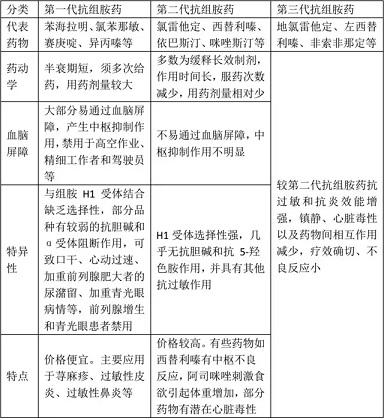Pheniramine (chlorpheniramine) is a “frequent” in commercially available cold medicines. As an antihistamine, chlorpheniramine can eliminate or reduce allergic symptoms such as tears, runny nose, sneezing, etc. caused by colds.
As a first-generation antihistamine, it has strong central nervous system activity and poor receptor specificity. It can cause significant sedation and anticholinergic effects, making patients drowsy or have difficulty concentrating on work. The second-generation antihistamines represented by loratadine and others have the characteristics of high H1 receptor selectivity, no sedative effect, separation of anticholinergic and antihistamine effects, and fewer adverse reactions in the central nervous system. .
Both are antihistamines, why do we need to use chlorpheniramine in cold medicine instead of the second generation such as loratadine?
There are three generations of antihistamines, and each generation is different
The first-generation antihistamines, represented by chlorpheniramine, can block the binding of histamine to H1 receptors on allergic target cells, but do not affect the metabolism of histamine, nor do they block the binding of histamine in the body. Release of histamine. At the same time, it has central depressant and anticholinergic effects. Diphenhydramine can also directly act on the cough center in the medulla oblongata, inhibiting the cough reflex.
The second-generation antihistamines represented by loratadine have strong selective antagonistic effects on peripheral histamine H1 receptors, but have low affinity for central histamine H1 receptors and are not effective on acetylcholine and adrenal glands. The α1 receptor has a very small effect, so it has no central sedative effect and no obvious anticholinergic effect. The side effects of first-generation antihistamines, such as drowsiness or difficulty concentrating at work, are greatly reduced.
The third-generation antihistamines represented by desloratadine are similar in pharmacological effects to the second-generation antihistamines, but they are more effective in anti-allergy and anti-inflammatory, sedative, and cardiotoxic than the second-generation antihistamines. And the interactions between drugs are reduced, the efficacy is accurate, and the adverse reactions are small.
Table 1 Introduction to third-generation antihistamines

First-generation antihistamines are the first-choice drugs for common colds
The “2012 Common Cold Diagnosis and Treatment Guidelines” clearly states that antihistamines have anti-allergic effects, inhibit the dilation of small blood vessels by blocking histamine receptors, reduce vascular permeability, and help eliminate or reduce sneezing in patients with common colds. and symptoms such as runny nose.
However, common adverse reactions of this type of drug include drowsiness, fatigue, etc., and should be used with caution by workers in industries such as driving vehicles and ships, working at heights, or operating precision instruments.
First-generation antihistamines, such as chlorpheniramine maleate and diphenhydramine, have the ability to cross the blood-brain barrier, penetrate human central nervous cells, and bind to histamine receptors. It has a high degree of anticholinergic effect, helps reduce secretions and relieve cough symptoms, so it is recommended as the first choice drug for common colds.
Although second-generation antihistamines have the advantages of non-drowsiness and non-sedation, they do not have anticholinergic effects and therefore cannot relieve cough.
The “Guidelines for the Diagnosis and Treatment of Cough (2015)” pointed out that there is no obvious clinical benefit from treatment with first-generation antihistamines alone. It is recommended that first-generation antihistamines such as chlorpheniramine maleate (2 to 4 mg/time, 3 times/d) combined with decongestants can improve cold-related sneezing, nasal congestion and other symptoms in adults and adolescents. .
For patients with cough caused by the common cold, central antitussive drugs have limited effectiveness in relieving cough and are not recommended for routine use. A combination of first-generation antihistamines, decongestants, and antitussives is recommended for the treatment of common colds associated with cough.
Apply to special groups with caution
Single use of first-generation antihistamines has no significant clinical benefit and is not recommended.
Infants and young children: Children under 2 years old need to be particularly careful when using medication; chlorpheniramine maleate is recommended for children.
Pregnant and lactating women: The U.S. FDA’s pregnancy safety classification of chlorpheniramine is Class B. Pregnant women should use it with caution. Taking diphenhydramine in early pregnancy may increase the incidence of cleft palate, inguinal hernia, and genitourinary malformations in infants. Domestic data recommends that it be contraindicated by women in early pregnancy. Diphenhydramine and chlorpheniramine maleate should be avoided during breastfeeding.
Elderly patients: Elderly people have many basic diseases and take more daily medications, so they need to pay attention to drug interactions. If there is no clear history of liver and kidney dysfunction, serious cardiovascular and cerebrovascular diseases, or gastrointestinal ulcer bleeding, normal dosage can be taken. If you are combined with the above diseases, you should refer to the medication guidelines for relevant populations.



 微信扫一扫打赏
微信扫一扫打赏
